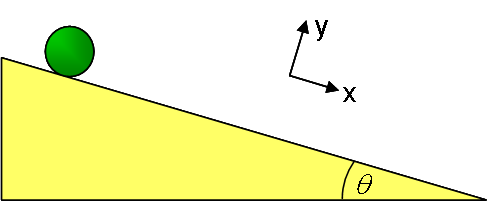Another way to solve the problem is to use energy. It turns out that in this problem, the mechanical energy of the ball will be constant. This assertion requires justification. The forces present in the system are gravity, normal force and friction. Gravity is a conservative force. The normal force is non-conservative, but it does no work because it is perpendicular to the motion of the object. Friction, however, is both non-conservative and directed anti-parallel to the motion of the ball, and so it should clearly do work. The reason we can assume the energy is constant is the problem's statement that the ball rolls without slipping. This means that the friction is static rather than kinetic. Kinetic friction converts mechanical energy into thermal energy and so it is not appropriate to use conservation of mechanical energy when kinetic friction is present. The work done by static friction, however, does not convert mechanical energy into thermal energy. Instead, the static friction acts to divert some of the lost potential energy into rotational kinetic energy (rather than simply translational kinetic energy). Thus, all of the energy remains in a mechanical form.
With this realization, we can write the equation of mechanical energy conservation in the form:
{latex}\begin{large}\[ K_{\rm f} + K_{\rm rot,f} + U_{\rm g,f} = K_{\rm i} + K_{\rm rot,i} + U_{\rm g,i} \]\end{large}{latex}
If we select _h_ = 0 at the point of release of the ball, then by the time the ball has moved a distance _x_ along the ramp, it has reached a height:
{latex} \begin{large}\[ h = - x \sin\theta\]\end{large}{latex}
Substituting zeros and appropriate expressions into the conservation of energy formula gives:
{latex}\begin{large}\[ \frac{1}{2}mv_{f}^{2}+ \frac{1}{2}I\omega_{f}^{2} - mgx\sin\theta = 0 \] \end{large}{latex}
Finally, the assumption that the ball is rolling without slipping implies the relationship:
{latex}\begin{large}\[ \omega_{f} R = v_{f}\]\end{large}{latex}
so:
{latex}\begin{large} \[ v_{f} = \sqrt{\frac{2gx\sin\theta}{1+\frac{\displaystyle I}{\displaystyle mR^{2}}}} \] \end{large}{latex}
{tip}The same result as obtained with method 1.{tip}
{info}Looking back at the equations of Part A, method 1 you can see that the friction force is:
{latex}\[ F_{f} = I\alpha /R \] {latex}
We know the value of α from Part A. Thus, using the fact that the work done by friction when the ball moves a distance _x_ down the ramp is _W_ = -- _xF_~f~ we can write:
{latex}\[ W = - \frac{xI}{R^{2}} \frac{g\sin\theta}{1+\frac{\displaystyle I}{\displaystyle mR^{2}}} \]{latex}
Now, using our result for _v_~f~, we can write this as:
{latex}\[ W = - \frac{1}{2}I \frac{v_{f}^{2}}{R^{2}} = - \frac{1}{2}I\omega_{f}^{2} = - K_{\rm rot} \]{latex}
Thus, the work done by friction is exactly equal to the rotational kinetic energy acquired by the ball.{info}
| 

System:
Interactions:
Model:
Approach:
Interactions:
Model:
Approach:
Approach:
System:
Interactions:
Model:
Approach: